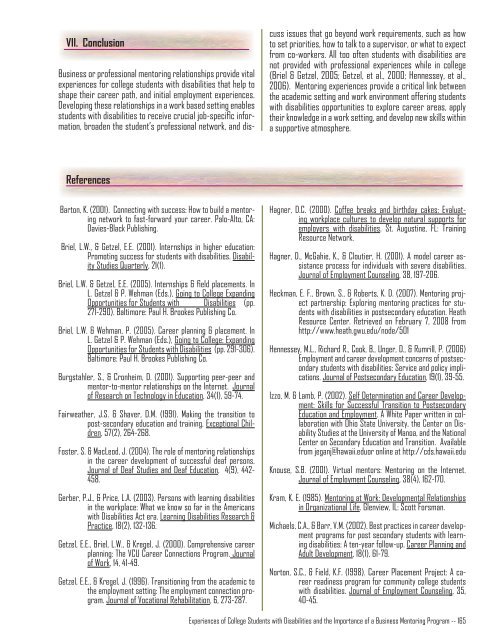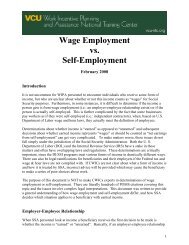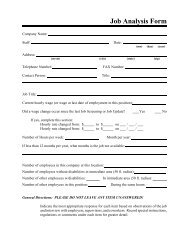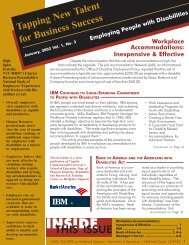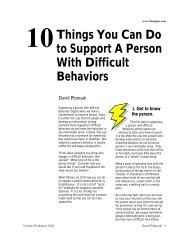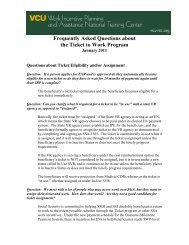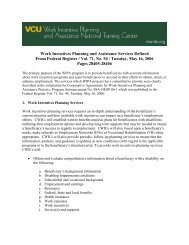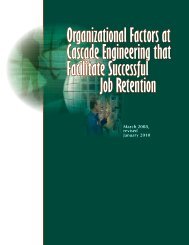are a beginning step towards better understanding effectivementoring activities and their impact on college juniors andseniors as they prepare to graduate and enter the workforce.However, some limitations should be noted. Researchis needed to further validate the information provided by thestudents’ e<strong>xperiences</strong>. The findings described are based onthe e<strong>xperiences</strong> <strong>of</strong> 25 college students <strong>with</strong> disabilities locatedat an urban university. Ideally, this research should be replicated<strong>with</strong> a greater number <strong>of</strong> students <strong>with</strong> disabilities fromvarious geographical regions and enrolled in varying sizes <strong>of</strong>two-and-four year colleges and universities. Second, the studywas designed to assess the effect <strong>of</strong> a mentoring programthrough work based meetings <strong>with</strong> students and their mentors.Further research is needed to determine the effectiveness <strong>of</strong>mentoring relationships developed through email contacts orthrough the use <strong>of</strong> other technologies. Finally, the study establishedspecific areas for the mentoring relationship based onthe current literature (i.e. career counseling, job shadowing,job placement assistance, conflict resolution/problem solving).These four areas became the focus <strong>of</strong> assisting students andtheir mentors to establish their relationship and to structureactivities at the work site. Other mentoring activities outside <strong>of</strong>the study’s four areas need examining to determine their effecton college students <strong>with</strong> disabilities’ career decision making.In spite <strong>of</strong> the limitations, the results provide important informationon facilitating mentoring e<strong>xperiences</strong> for collegestudents <strong>with</strong> disabilities. Given a relatively open structurefor students and mentors to identify and agree on severallearning objectives to center the mentoring experience, thetwo primary areas <strong>of</strong> focus for a majority <strong>of</strong> the student participantsinvolved career counseling and job placement assistanceactivities. <strong>Students</strong> expressed the importance <strong>of</strong> mentorsto assist in exploring career options and clarifying theircareer goals. Being able to meet at the work site, be a part<strong>of</strong> the workplace culture, or use pr<strong>of</strong>essional work materialsprovided a better understanding <strong>of</strong> the work environment andthe skills required in their field <strong>of</strong> study. Mentors providedstudents <strong>with</strong> relevant resources through topic related books,pr<strong>of</strong>essional handbooks, printed materials and organizationwebsites to assist them in further researching their careerinterests. Student participants were provided opportunitiesto discuss the demands <strong>of</strong> the work environment and their disabilityin a non-threatening atmosphere. This is particularlycritical for students <strong>with</strong> disabilities who need opportunities toassess work environments and determine steps they can taketo ac<strong>com</strong>modate their disability in these environments (Briel &Getzel, 2005; Getzel, et al., 2000; Hennessey, et al., 2006).The majority <strong>of</strong> students identified networking activities asa focal point <strong>of</strong> their mentoring relationships. Many studentswere able to meet and interview colleagues in the same department,neighboring departments, and human resource directorsfor the <strong>com</strong>pany. These activities fall under the job placementassistance area and provided student participants <strong>with</strong> criticalopportunities to begin building pr<strong>of</strong>essional networks prior tograduation. <strong>College</strong> students <strong>with</strong> disabilities are in need <strong>of</strong> opportunitiesto establish contacts in the field to assist in securingemployment (Briel & Getzel, 2005; Hennessey, et al., 2006;Michaels & Barr, 2002).Another aspect <strong>of</strong> job placement assistance activities involvedparticipants receiving input and feedback on their resumesor resources to assist in their development. <strong>Students</strong> <strong>with</strong>disabilities were able to learn how to organize and describetheir relevant e<strong>xperiences</strong> and to emphasize valued skills andabilities in the field. These students were able to develop pr<strong>of</strong>essionalresumes to assist them when <strong>com</strong>peting for futureemployment opportunities in their chosen career. The thirdcritical skill area that students <strong>with</strong> disabilities were able toreceive as part <strong>of</strong> job placement assistance was strengtheningtheir interviewing skills. Mentors participated in mock interviewsessions for students, <strong>of</strong>fered interviewing tips, andcoordinated opportunities for informational interviews <strong>with</strong>colleagues.The two remaining areas <strong>of</strong> job shadowing and conflict resolution/problemsolving were also viewed by students as importantaspects <strong>of</strong> their mentoring relationship, but were nota central part <strong>of</strong> most students’ mentoring e<strong>xperiences</strong>. Thiscould be a result <strong>of</strong> the primary interests <strong>of</strong> the students atthe time <strong>of</strong> the mentoring experience or the availability <strong>of</strong> individualsin the work environment to provide job shadowinge<strong>xperiences</strong>. For those students who did participate in jobshadowing opportunities, their e<strong>xperiences</strong> were found to beextremely beneficial. Having access to situations otherwiseclosed, such as observing in a courtroom or experiencing behindthe scenes work required to put together a news story,not only <strong>of</strong>fers the student new knowledge, but can also increasemotivation.It is also worth noting that the final area <strong>of</strong> the study, conflictresolution/problem solving was primarily intended to bea <strong>com</strong>ponent <strong>of</strong> the follow up work by project staff <strong>of</strong> studentparticipants graduating from VCU and entering the workforce.The data obtained from this phase <strong>of</strong> the study will analyzewhether or not the mentoring relationship continued postgraduation or if the information provided during the mentoringexperience in college impacted students once they enteredthe work environment. This data set will hopefully provideinsight on the effect <strong>of</strong> the mentoring relationship assistingstudents <strong>with</strong> disabilities in conflict resolution/problem solvingin their employment setting. For some students who wereparticipating in part time employment or internships while attendingVCU, the mentoring relationships did include activitiesthat addressed conflict resolution/problem solving. Specificareas identified by students included learning stress managementtechniques, understanding potential issues related to acareer, and learning how to request ac<strong>com</strong>modations and facepotential barriers in the workplace.164
VII. ConclusionBusiness or pr<strong>of</strong>essional mentoring relationships provide vitale<strong>xperiences</strong> for college students <strong>with</strong> disabilities that help toshape their career path, and initial employment e<strong>xperiences</strong>.Developing these relationships in a work based setting enablesstudents <strong>with</strong> disabilities to receive crucial job-specific information,broaden the student’s pr<strong>of</strong>essional network, and dis-cuss issues that go beyond work requirements, such as howto set priorities, how to talk to a supervisor, or what to expectfrom co-workers. All too <strong>of</strong>ten students <strong>with</strong> disabilities arenot provided <strong>with</strong> pr<strong>of</strong>essional e<strong>xperiences</strong> while in college(Briel & Getzel, 2005; Getzel, et al., 2000; Hennessey, et al.,2006). Mentoring e<strong>xperiences</strong> provide a critical link betweenthe academic setting and work environment <strong>of</strong>fering students<strong>with</strong> disabilities opportunities to explore career areas, applytheir knowledge in a work setting, and develop new skills <strong>with</strong>ina supportive atmosphere.ReferencesBarton, K. (2001). Connecting <strong>with</strong> success: How to build a mentoringnetwork to fast-forward your career. Palo-Alto, CA:Davies-Black Publishing.Briel, L.W., & Getzel, E.E. (2001). Internships in higher education:Promoting success for students <strong>with</strong> disabilities. DisabilityStudies Quarterly, 21(1).Briel, L.W. & Getzel, E.E. (2005). Internships & field placements. InL. Getzel & P. Wehman (Eds.), Going to <strong>College</strong> ExpandingOpportunities for <strong>Students</strong> <strong>with</strong> Disabilities (pp.271-290). Baltimore: Paul H. Brookes Publishing Co.Briel, L.W. & Wehman, P. (2005). Career planning & placement. InL. Getzel & P. Wehman (Eds.), Going to <strong>College</strong>: ExpandingOpportunities for <strong>Students</strong> <strong>with</strong> Disabilities (pp. 291-306).Baltimore: Paul H. Brookes Publishing Co.Burgstahler, S., & Cronheim, D. (2001). Supporting peer-peer andmentor-to-mentor relationships on the Internet. Journal<strong>of</strong> Research on Technology in Education, 34(1), 59-74.Fairweather, J.S. & Shaver, D.M. (1991). Making the transition topost-secondary education and training. Exceptional Children,57(2), 264-268.Foster, S. & MacLeod, J. (2004). The role <strong>of</strong> mentoring relationshipsin the career development <strong>of</strong> successful deaf persons.Journal <strong>of</strong> Deaf Studies and Deaf Education, 4(9), 442-458.Gerber, P.J., & Price, L.A. (2003). Persons <strong>with</strong> learning disabilitiesin the workplace: What we know so far in the Americans<strong>with</strong> Disabilities Act era. Learning Disabilities Research &Practice, 18(2), 132-136.Getzel, E.E., Briel, L.W., & Kregel, J. (2000). Comprehensive careerplanning: The VCU Career Connections Program. Journal<strong>of</strong> Work, 14, 41-49.Getzel, E.E., & Kregel, J. (1996). Transitioning from the academic tothe employment setting: The employment connection program.Journal <strong>of</strong> Vocational Rehabilitation, 6, 273-287.Hagner, D.C. (2000). C<strong>of</strong>fee breaks and birthday cakes: Evaluatingworkplace cultures to develop natural supports foremployers <strong>with</strong> disabilities. St. Augustine, FL: TrainingResource Network.Hagner, D., McGahie, K., & Cloutier, H. (2001). A model career assistanceprocess for individuals <strong>with</strong> severe disabilities.Journal <strong>of</strong> Employment Counseling, 38, 197-206.Heckman, E. F., Brown, S., & Roberts, K. D. (2007). Mentoring projectpartnership: Exploring mentoring practices for students<strong>with</strong> disabilities in postsecondary education. HeathResource Center. Retrieved on February 7, 2008 fromhttp://www.heath.gwu.edu/node/501Hennessey, M.L., Richard R., Cook, B., Unger, D., & Rumrill, P. (2006)Employment and career development concerns <strong>of</strong> postsecondarystudents <strong>with</strong> disabilities: Service and policy implications.Journal <strong>of</strong> Postsecondary Education, 19(1), 39-55.Izzo, M. & Lamb, P. (2002). Self Determination and Career Development:Skills for Successful Transition to PostsecondaryEducation and Employment. A White Paper written in collaboration<strong>with</strong> Ohio State University, the Center on DisabilityStudies at the University <strong>of</strong> Manoa, and the NationalCenter on Secondary Education and Transition. Availablefrom jeganj@hawaii.eduor online at http://cds.hawaii.eduKnouse, S.B. (2001). Virtual mentors: Mentoring on the Internet.Journal <strong>of</strong> Employment Counseling, 38(4), 162-170.Kram, K. E. (1985). Mentoring at Work: Developmental Relationshipsin Organizational Life. Glenview, IL: Scott Forsman.Michaels, C.A., & Barr, V.M. (2002). Best practices in career developmentprograms for post secondary students <strong>with</strong> learningdisabilities: A ten-year follow-up. Career Planning andAdult Development, 18(1), 61-79.Norton, S.C., & Field, K.F. (1998). Career Placement Project: A careerreadiness program for <strong>com</strong>munity college students<strong>with</strong> disabilities. Journal <strong>of</strong> Employment Counseling, 35,40-45.E<strong>xperiences</strong> <strong>of</strong> <strong>College</strong> <strong>Students</strong> <strong>with</strong> Disabilities and the Importance <strong>of</strong> a Business Mentoring Program -- 165


